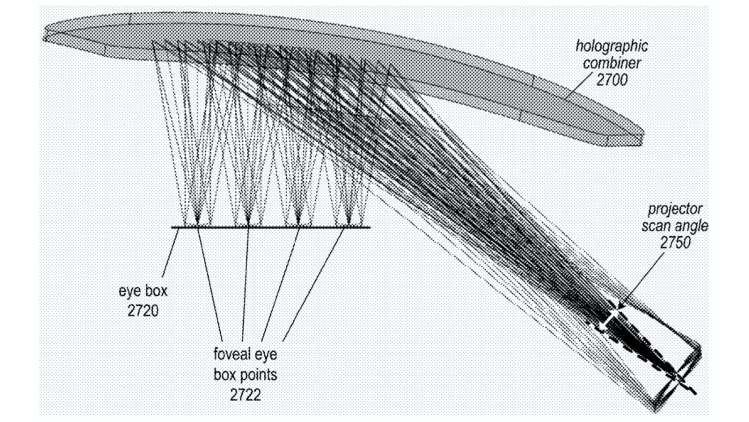If Apple-developed AR glasses didn’t already strike you as unlikely to appear this year, a possible implementing technology — miniature projectors that beam holograms directly into your eyes — may be enough to convince you that the company’s research is at least a little ahead of its time. A just-published patent application establishes that Apple is still working on the novel display technology, regardless of the shipping timeline.
While the technical details of the application are complex, the innovation appears to be a projector that beams multiple tiny points of light onto a lens, creating a hologram that can be seen within a specific “eye box” area. Unlike a flat screen inserted within the lens, the projected hologram would appear to have multiple fields of view, and thus three-dimensional depth that would match both the user’s eyes and ambient environment.
To put the filing in context, Apple has reportedly been researching retinal display technologies for years, and in 2017, leaked internal safety reports suggested that employees may have been injured by prototypes using eye-directed lasers. In August 2018, Apple purchased Akonia Holographics, a maker of AR lenses that promised “thin, transparent smart glass lenses that display vibrant, full-color, wide field-of-view images.”
The new patent application confirms that a projector emitting an array of lasers would use multiple light waveguides, mirrors, holographic lenses, and a holographic combiner to create the 3D augmented imagery. A total of eight projectors could be used to overlap four focused foveal and four further-away peripheral images, creating greater depth.
Beyond the concepts necessary to make this happen, actually mass-manufacturing AR glasses with the technology would appear to call for microscopic lenses and other parts that are of questionable availability at this point — say nothing of the continued safety concerns of directing lasers into users’ eyes. Consequently, it’s far from certain that Apple would begin moving into AR glasses with this technology rather than something less radical, though the company (and Akonia) may well be further through testing and early manufacturing than is widely known.
Developers have continued to spot references to a “Starboard” stereoscopic AR solution in iOS 13, most recently pointing at accessories that may only be supported by iPhone 11 and later devices. On the hardware front, Apple has said only that it views AR as a potentially major area of interest, while releasing ARKit and related software to spur developer prototyping of AR apps for iOS and iPadOS devices. Conflicting reports have suggested that the company either killed an ambitious AR hardware project or one of two competing projects, perhaps in favor of something that could be shipped next year.

